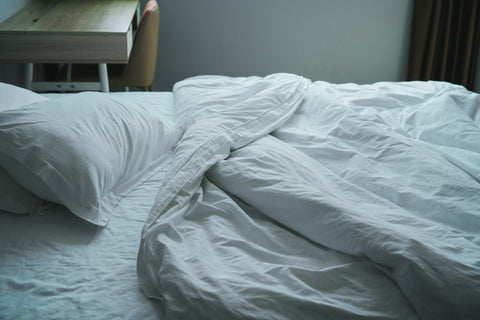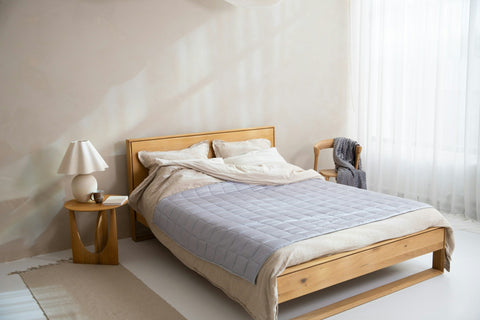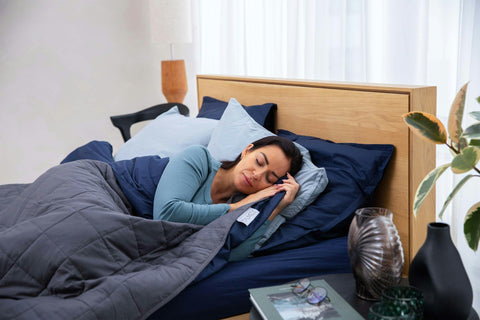
Nothing beats the comfort of hotel-quality bedding. With the proper support and cushioning, you can drift off to sleep and stay asleep throughout the night. While sheets and pillows are essential, nothing is as game-changing as a good down comforter. If you're looking for a way to upgrade your bedding for a better night's sleep, a fluffy down duvet should be at the top of your list. First, though, you need to know what to look for in a down comforter. How to choose bedding is just as important as what you choose. This guide will help you find the perfect down duvet that delivers hotel-level comfort, lasting warmth, and cloud-like softness for a luxurious night's sleep at home.
Yumerest's cloud-like, fluffy duvets and exceptional down comforters are ideal for achieving your bedding upgrade goals. With their soft coverings, ultra-plush fill, and lightweight construction, these comforters provide a cozy yet breathable feel that will keep you sleeping soundly and comfortably all night long.
What is a Down Comforter?

A down comforter is a type of bedding filled with down, the undercoat of birds, and is known for its super-soft, fluffy, and lightweight quality. While they are lightweight, they have excellent insulating abilities. Typically, these comforters have chambers, most commonly a baffle box stitch, that is filled with down feathers to prevent them from shifting or clumping.
Types of Down: Picking a Filling That Works for You
Goose
Goose down is the most commonly used type of down for down comforters. It is most commonly found in white and gray, but white goose down is typically used with white comforter shells, allowing you to see through it.
Duck
Duck down is very similar to goose down, except the feathers are plucked from a duck. It is less insulated than goose down, making it more affordable.
Down & Feather Blend
This combines both down and feathers into one fluffy blend. A reminder that down is the lush undercoat of a bird, so the addition of feathers will create a similar softness to that of a feather-filled pillow. These blends are typically more affordable.
Alternative Down Fill
Avoid allergy issues and get the luxury of down with down-alternative fills. These comforters utilize a mix of synthetic fibers for a quality loft that's hypoallergenic. Popular down alternatives include polyester, cotton, wool, and more.
Benefits of a Down Comforter: Why You Will Love It
Down comforters offer several benefits, making them a popular choice for bedding in all seasons. Here are a few key advantages:
Lightweight Warmth
Down comforters are incredibly warm yet lightweight, making them ideal for those who want to stay cozy without feeling weighed down.
Temperature Regulation
Down feathers allow for natural air circulation, helping to prevent overheating by wicking away moisture.
Durability
With proper care, a high-quality down comforter can last for years, making it a worthwhile investment.
Hypoallergenic Options
Many down comforters are treated to be hypoallergenic, ensuring comfort for individuals with allergies or sensitivities.
Down Comforters and Allergies
Many people have misconceptions about whether down products cause allergy flare-ups. Research suggests that down itself is no more allergenic than alternative materials. Dust mites and mold from unwashed bedding can cause flare-ups, but these allergens can affect almost any type of bedding material.
Those concerned about potential allergens in a down comforter should look in the product description to see if the company washes the down to remove dirt and dust.
|
Pros |
Cons |
|
|
Related Reading
- Why Are My Sheets Itchy
- Are Microfiber Sheets Good for Skin
- Are Bamboo Sheets Hypoallergenic
- Do Bamboo Sheets Wrinkle
- Why Are Duvet Covers So Expensive
What to Look for in a Down Comforter

Down comforters are made from either goose down or duck down. Goosedown has larger clusters, traps more heat, and creates warmer comforters. Because of this, goose-down comforters are more expensive and more popular than duck-down models.
Duck down, on the other hand, has smaller clusters, traps less heat, and costs less as a result. If you're looking for a budget-friendly option for down comforters, duck down is still a solid choice, although it may be slightly less warm than goose down.
Warmth Level: What You Need for Your Climate
One major component that can influence which comforter you choose is the warmth level you’re looking for. Is the comforter for cold weather, warm seasons, or year-round use? To determine the ideal warmth level, consider a potential comforter’s fill power and fill weight. These two aspects assess the level of warmth a comforter provides.
Fill Power: What Is It?
Fill power is defined by the amount of material contained within one ounce of fabric and is measured in grams per square meter (GSM). The higher the fill power, the more insulation a down comforter provides. Most comforter brands list the GSM in the product description or specifications.
The label on a down comforter typically indicates its fill power. This number relates to the quality of the down feathers used in the comforter. The higher the fill power, the larger and better the quality of the down used. A higher rating also relates to a fluffier, lighter, more breathable, and warmer comforter.
Understanding Fill Power and Down Quality
The down is pre-washed, sterilized, and measured to obtain the space it occupies in cubic inches. The most expensive down generally has a fill power of over 700 cubic inches. These down alternatives outlast down with a lower rating, which have smaller and more fragile clusters of down.
A lower quality down will be less than 400. An average or mid-level comforter typically has a rating of approximately 500 cubic inches. A higher fill power down occupies more space than the same amount of down with a lower fill power.
Best Fill Power by Season: Spring to Winter
For example, if you’re looking for a spring or summer comforter, the fill power should be 400 GSM or less. For a cold-weather comforter, choose one with a GSM rating of 600 or higher. Then, if you want to enjoy a year-round comforter, the fill power should be between 400 and 600.
Fill Weight: What Is It?
Fill weight refers to the number of ounces inside a comforter. Fill weight is the driving force behind how much warmth a comfort has. The higher the fill weight, the warmer the comforter.
Shell Material: What Is It and What Are the Options?
The outer material that encases the fill is the down comforter’s shell. Shells can be made from a variety of fabrics, but the two most common are cotton and silk. Some brands may have cotton-blend or polyester shells, but these materials are typically found in down alternative comforters.
Stitching: How Does It Affect Performance?
How the comforter is stitched affects not just the blanket’s appearance but also how the fill is distributed. Stitching prevents fill from clumping in one area, allowing you to enjoy a soft, even surface.
Filling that bunches up in a specific section doesn’t give you balanced warmth. One side of the bed may feel warmer than the other. Down comforters have one of four basic stitchings: baffle box, gusseted, sewn through, and diamond quilt.
Weave: What Is It?
Weave refers to how the shell material is woven and can significantly impact the comforter's feel. Weave also affects a comforter’s breathability. There are two common types of weave:
Percale
Percale is a close-knit weave containing thinner threads. This plain weave has a crisp, lightweight feel compared to the denser sateen weave, offering a cooler sleep experience.
Sateen
Sateen uses thicker threads in its weave, producing a heavier material with a silk-like sheen. The sateen weave is also breathable but is warmer than percale. If you prefer smoother material, sateen is your best option.
Thread Count: What Is It?
Thread count refers to the number of fibers woven together to create one square inch of fabric. Thread counts range from 250 to over 1,000, but beware of any bedding material with a thread count exceeding 800. Most materials with higher thread count are not durable.
Plus, it’s impossible to fit that many single-ply threads in one square inch. Some bedding manufacturers separate single-ply fibers and twist them together to create multi-ply fibers. Instead of counting the single-ply fiber as one thread, they count each fiber, thereby increasing the thread count and making a down comforter appear more luxurious than it is.
Choosing the Right Thread Count for Your Comforter
Some down comforters have higher prices because they have a higher thread count. Separating a single-ply fiber makes the thread weaker. A high thread-count comforter may only last a few years compared to a comforter with a thread count under 800.
If you’re looking for an all-season down comforter, the thread count “sweet spot” to look for is between 300 and 500. A comforter with a 500- to 700-thread count is ideal for use in cold weather.
Comforter Size: Why It Matters
When it comes to finding the right comforter size, the dimensions are not exact when comparing several down comforters of the same size. Some may appear longer or shorter than others.
That’s because bedding manufacturers add or remove inches to adjust how a comfort drapes over the side of the bed. You want a down comforter to drape over the mattress, fully covering the bed’s sides.
How to Choose the Right Comforter Size for Your Bed
The best way to find the right-sized comforter is to measure the thickness of your mattress and add those inches to each side of the bed’s measurements. For example, a queen-size mattress is 60 inches wide and 80 inches long. If your bed is 12 inches thick, add 12 to each side, meaning that your comfort should be at least 72 inches wide and 92 inches long.
Seasonal vs. Year-Round: What’s the Difference?
Not all comforters are built for year-round use. Some bedding companies create comforters meant for specific seasons. Manufacturers typically specify whether a particular comforter is suitable for warm climates or cold weather. Check the product description to determine if a potential comforter is ideal for seasonal or year-round use.
Maintenance: What to Know Before You Buy
Keep in mind that most down comforters are dry-cleaned only because down feathers contain natural oils. These natural oils are what keep feathers nice and fluffy. Chemicals from laundry detergent strip the down feathers of these oils, causing the down comforter to lose its fluffiness.
Dry cleaners use special solvents to effectively clean your comforter without damaging the material. Refer to the care instructions to learn how to maintain your down comforter properly. Following these guidelines helps the comfort to last for years to come.
Extend Your Comforter's Life with a Duvet Cover
Another way to help your down comforter last is by adding a duvet cover. Many down comforter brands have built-in corner tabs to secure the comfort inside a duvet cover.
Duvet covers protect your down comforter from stains. In case of an accident, simply remove the duvet cover and place it in the washing machine for easy cleanup.
Warranty: Why It Matters
A warranty reassures customers of a sound purchase. Enjoy your down comforter fully without having to replace it because of any manufacturing defects prematurely. These defects include loose seams and small tears.
In case of a defect, the warranty allows you to exchange the faulty comforter for repairs or a replacement. Most comforter warranties last approximately a year, although some may be longer, depending on the brand.
Quality Checks To Look For In Down Comforters
These certifications assure consumers about the safety, quality, and ethical production of the down comforters, addressing both environmental and social concerns related to their manufacturing process.
OEKO-TEX® Certification
This certification ensures that the materials used in the product, including the down and fabric, have been tested for the presence of harmful substances.
When a down comforter is OEKO-TEX® certified, it means that it has met stringent criteria regarding human-ecological safety, indicating that the product is free from harmful chemicals and safe for use.
RDS (Responsible Down Standard) Certification
This certification ensures that the down and feathers used in the comforters come from geese or ducks that are ethically and responsibly treated. It verifies that the animals were not subjected to unnecessary harm, including force-feeding or live-plucking, and that they were raised in humane conditions.
RDS certification ensures that consumers can trust the down used in the comforters is sourced from suppliers that prioritize animal welfare.
Long-term value considerations
Investing in a high-quality down comforter can really pay off over time, especially when considering long-term value. When setting your budget, consider that down comforters range from $90 to $900, depending on factors like fill power, down type, and size.
Higher fill power, 600 and above, means better insulation and durability, which can justify a higher price tag. Goose down is typically more expensive but offers superior warmth and longevity compared to duck down.
Choosing the Right Comforter for Long-Term Comfort
If you’re looking for the best long-term value, prioritize comforters with baffle box construction, as they maintain loft and warmth levels more effectively over time. Consider how you sleep; a lightweight comforter may suffice for warm climates, while those in colder areas should invest in heavier options.
Related Reading
- Duck Down vs Goose Down
- Bed Sheet vs Bed Cover
- What Comes in a Sheet Set
- Best Time to Buy Sheets
- What Color Bed Sheets Should I Get
Down vs. Down Alternative Comforters

Down alternative comforters are typically filled with synthetic fibers that mimic the feel of down. Both down-and-down alternative comforters have a similar plush and lofty feel, helping to keep you warm throughout the night.
Real down tends to be more expensive and retain more warmth but has a higher potential for allergens. Meanwhile, down alternatives are often less costly and cooler but can’t perfectly replicate the plushness of real down.
|
Down Comforters |
Down Alternative Comforters |
|
|
Fill |
Down is made from the plumage under a duck or goose’s feathers. It forms in clusters and has a distinctly soft feel. |
Down alternative comforters can be made from natural or synthetic materials. PrimaLoft, polyester, and microfiber are popular options, while cotton, silk, and wool are rarer. |
|
Temperature Regulation |
Down is a naturally insulating material that gives bedding a cozy and warm feel. |
Down alternative is often not as insulating as real down, but it still offers warmth and comfort. |
|
Breathability |
A down comforter can be exceptionally breathable if it has a low fill power, but higher fill powers tend to trap heat. |
Down alternative comforters are generally less likely to cause overheating. |
|
Allergens |
Down can trap dust, mold, or mildew, which can exacerbate allergies. Many companies wash down fill to mitigate this issue. |
Down alternative fibers often resist allergens. |
|
Durability |
Down is one of the most durable bedding materials. |
Down alternative fibers tend not to last as long as real down. |
|
Comfort & Feel |
Down comforters have a distinct plush and lofty feel that keeps you warm throughout the night. |
Down alternative comforters mimic the feel of real down, but they can not replicate it exactly. |
|
Cleaning & Care |
Down comforters often require professional cleaning to avoid damage. |
Most down alternative comforters are machine-washable and easy to clean. |
|
Price |
Most people can expect to spend at least $150 on a down comforter, but many cost more. |
Down alternative comforters come in a wide range of prices. Some cost less than $50, and others can cost more than $200. |
Which Is Best for Your Needs?
If you prefer an exceptionally soft and lofty comforter, it’s hard to beat the feeling of real down. We recommend choosing down if you prefer a cozy, warm top layer and are willing to spend a bit more on a comforter made with one of the most durable bedding materials.
You may prefer a down alternative comforter if you sleep hot, as they regulate temperature more effectively. Down alternatives can also resist dust and other allergens better than real down. Most down alternative comforters don’t contain animal products, making them excellent options for vegan and animal-conscious shoppers as well.
You Should Go for Down Comforters If
You enjoy cozy and warm comforters. You’re willing to spend a bit more on a comforter made with durable materials. You prefer exceptionally soft and lofty comforters.
You Should Go for Down Alternative Comforters If
You are sensitive to allergens like dust, mold, or mildew. You are animal-conscious or vegan and prefer not to buy bedding made with animal products. You are a particularly hot sleeper who overheats with real down.
Get Deep Sleep Every Night with Our Cloud-like, Soft, Fluffy Duvets
Yumerest's PureFlow Duvet transforms your bedroom into a luxurious sanctuary, enveloping you in cloud-like softness with its exceptional 5kg filling, which promotes deeper and more restorative sleep.
Cozy Canadian Duvet with Ethical Down
This premium Canadian duvet stands apart from competitors like Happy Fluffy Cloud and Hush through its ethically sourced northern down that perfectly regulates temperature year-round, never too hot, just perfectly cozy.
Crafted by expert artisans using techniques perfected since 1946, our duvets combine traditional craftsmanship with modern innovation to deliver an unparalleled sleeping experience.
PureFlow Bundle for Deep, Restful Sleep
The PureFlow bundle, featuring our heavenly duvet, elegant cover, and calming sleep mist, creates a complete sleep sanctuary that helps busy professionals and parents finally achieve the rejuvenating rest they deserve.
Enjoy deep sleep every night with our cloud-like, fluffy duvets.
Related Reading
- How Long Do Bed Sheets Last
- Duvet Thread Count Guide
- GSM vs Thread Count
- Microfiber vs Flannel Sheets
- Best Egyptian Cotton Sheets
- Best Sheets for Sensitive Skin







